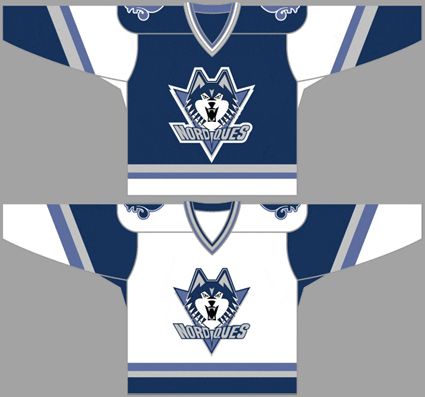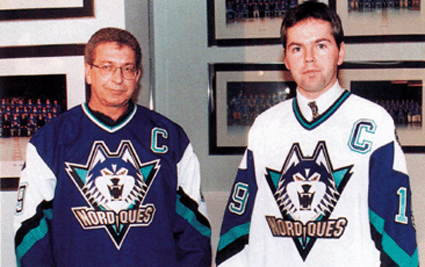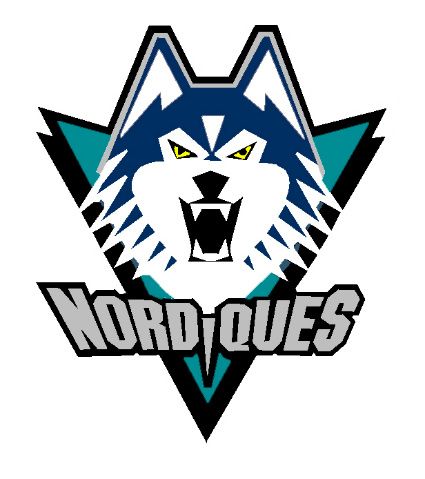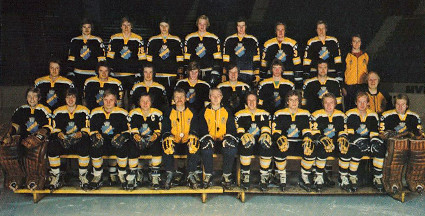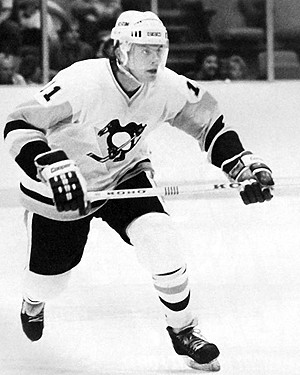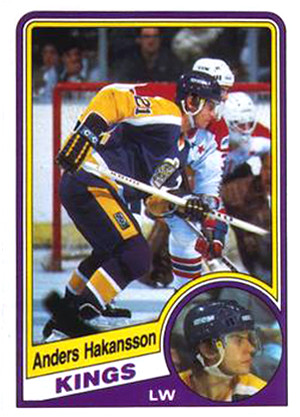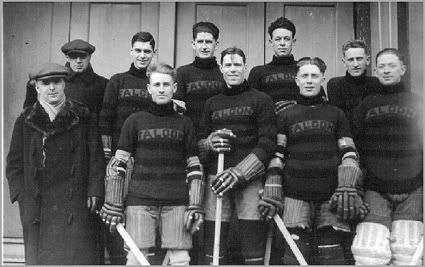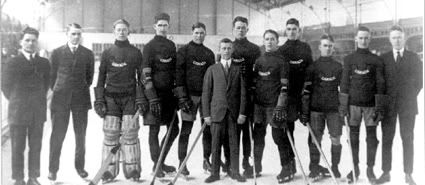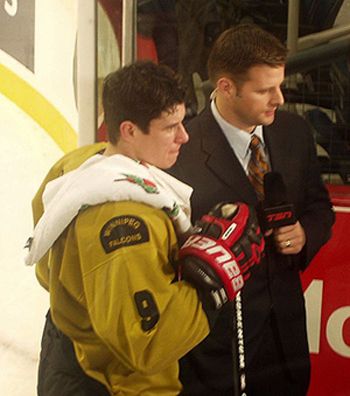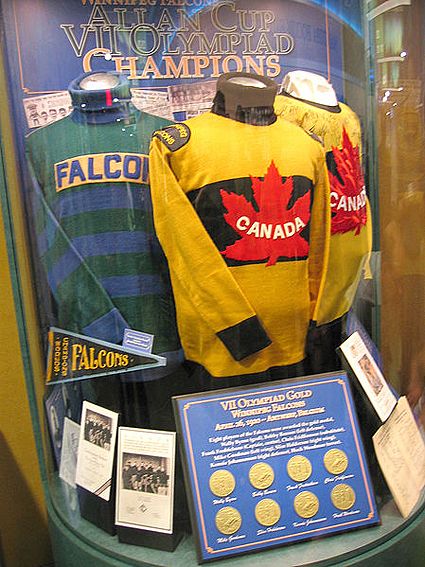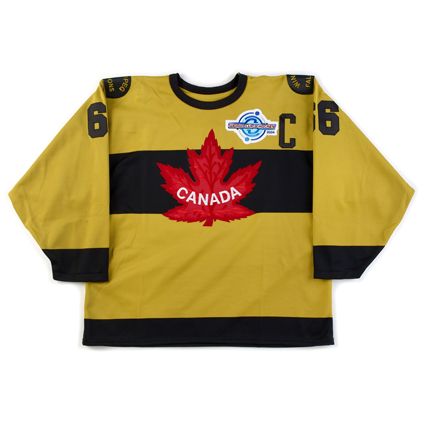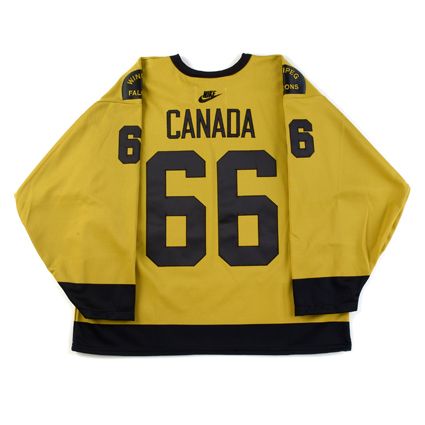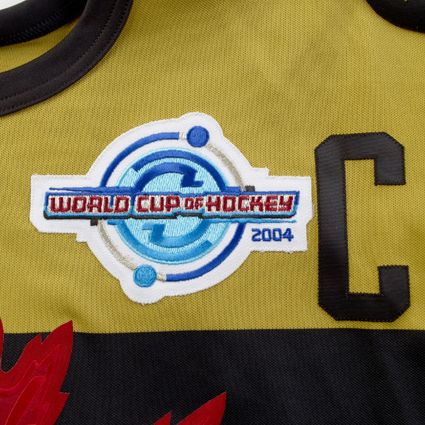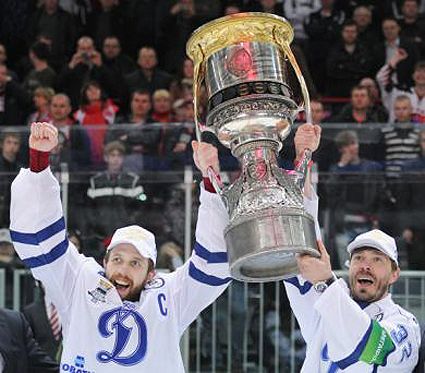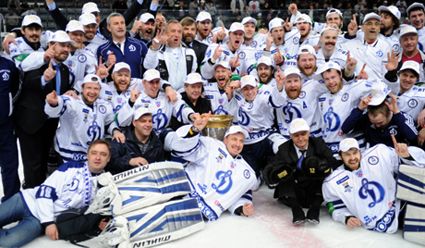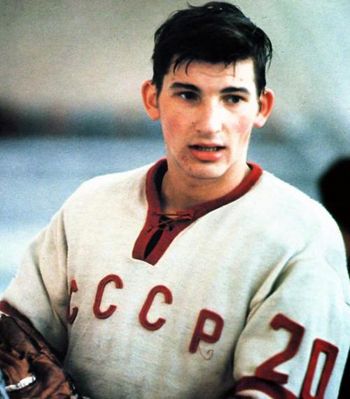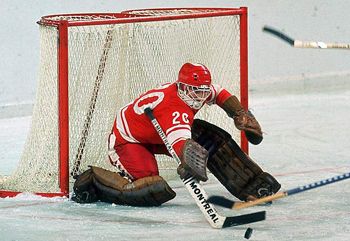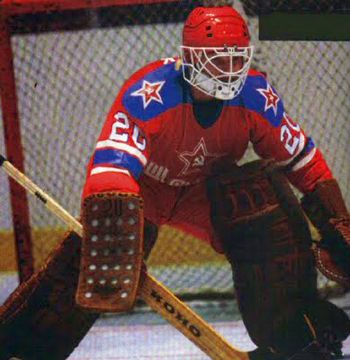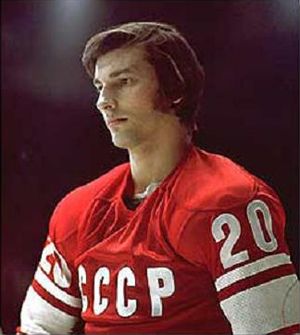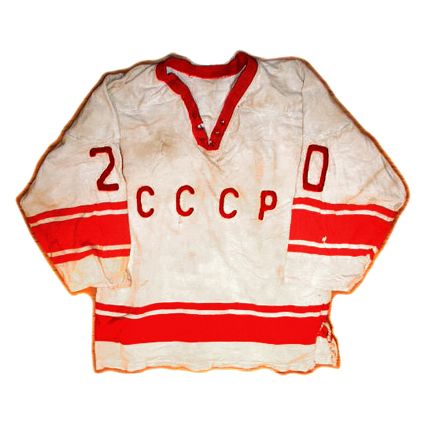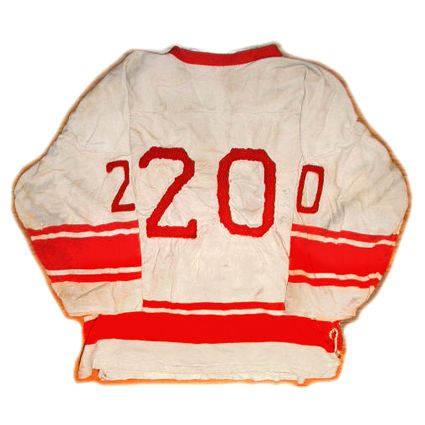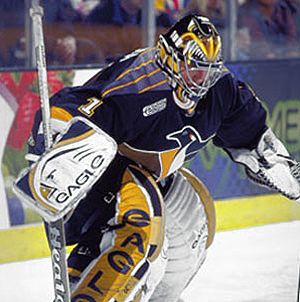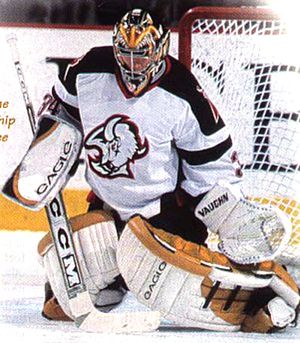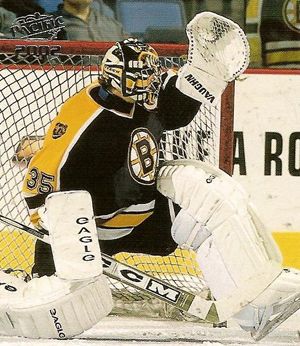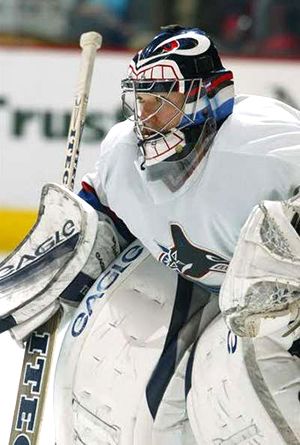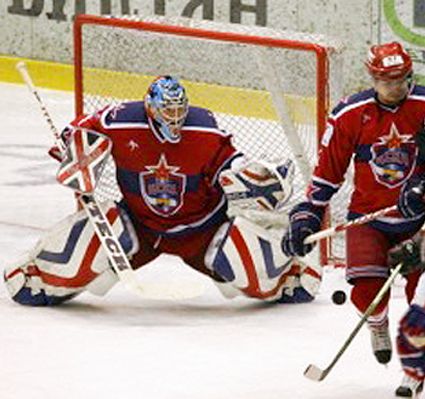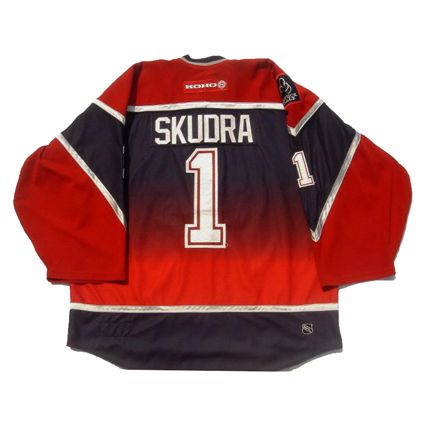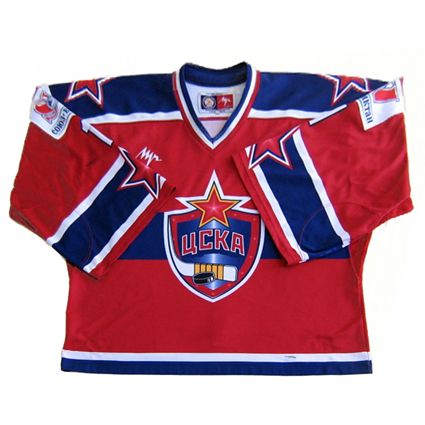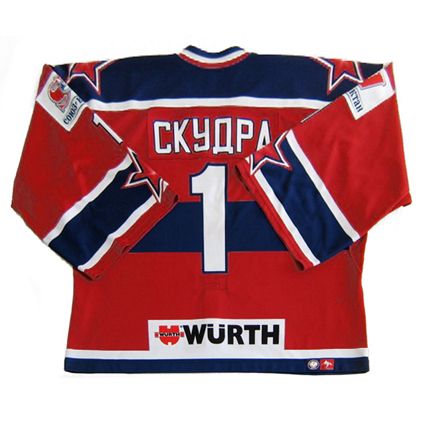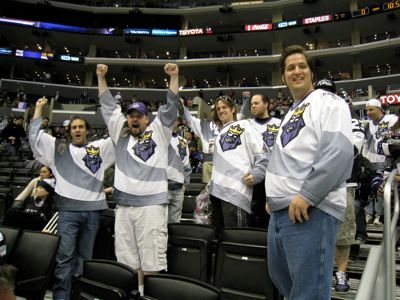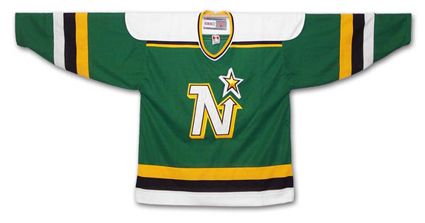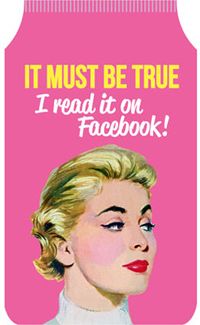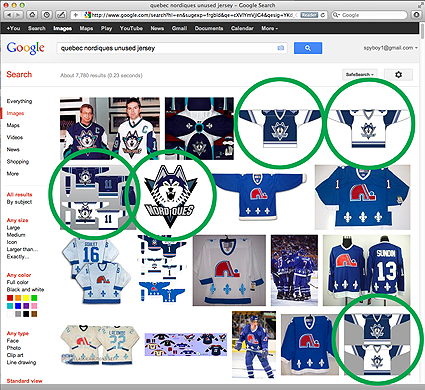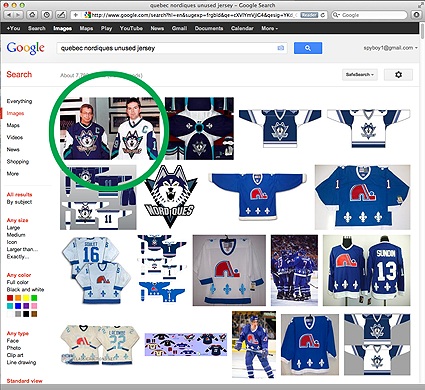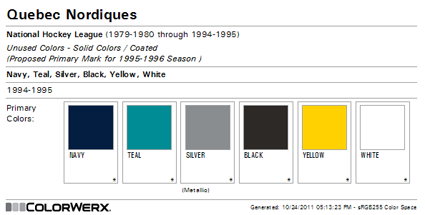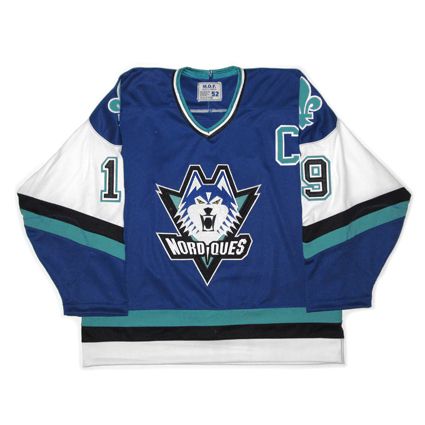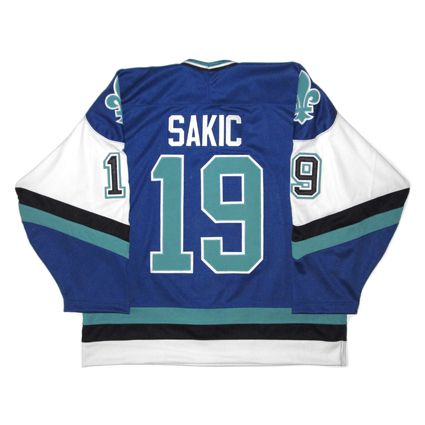Most NHL jerseys have a normal, predictable lifespan. They are designed, produced, worn for a period of time, ranging from a couple of years to decades.
A few are worn for a brief period of time, such as some of the unfortunate designs among the earliest of the third jerseys like the Mighty Ducks of Anaheim "
Wild Wing" and the Los Angeles Kings "
Burger King" jerseys, which were worn during the second half of the 1995-96 season for approximately six games each before being abandoned for good. But still, those designs live on, as they were produced in retail versions for fans to purchase and still to this day fetch big dollars on ebay, keeping them in the public eye.
The King lives on thanks to Burger King Jersey Appreciation Day
On the other hand, some jerseys have come and gone, sometimes for years, before making a comeback as a vintage jersey re-release, which can cause the finer details of the jersey to blur over the passage of time. A perfect case in point are the
Minnesota North Stars jerseys of the late 1980's. When those were first remade by CCM, either someone did not pay attention to the details or there were gaffes in production that went unnoticed, such as the star above the "N" in the crest being sewn on backwards, which caused the star to lean to the left, while the italicized "N" was tilted properly to the right.
A CCM North Stars remake with the star sewn on backwards
Additionally, the specs for the customization of the numbers was also botched, as the "drop shadow" of the numbers went up and to the left, thanks to the top layer of white twill for the number being improperly sewn onto the bottom right of the yellow layer of twill, rather than the top left of the yellow layer, which would have created a proper drop shadow going down and to the right. It's hard to imagine how this was allowed to continue past the initial production run, as the biggest clue as to how the drop shadow was supposed to look was sitting there in plain sight on the other side of the jersey in the form of the main crest!
Another such case of an incorrect version of a jersey becoming considered gospel is the legendary 1996-97 Quebec Nordiques Unused Jersey, which never actually saw action in the NHL, owing to the franchise relocating to Denver, Colorado for the 1995-96 season before the Nordiques could debut their planned new design.
What has happened with the proposed Nordiques jersey was that a contributor to the
Chris Creamer Sports Logo Community drew the image below of the proposed home and away jerseys based on a black and white photo scanned from a newspaper, knowing only the intended main color of the jerseys was to be navy blue, and was forced to take an educated guess on the other colors based solely on the tones of the shades of grey in the black and white image. Once completed, that artwork was publicly posted on the Sports Logo Community forum.
That one
image,
based on an educated, but ultimately incorrect, guess, then began to be discovered through image searches, copied and reposted other places online
without any idea the original artist had no information on the actual colors to work with.
The widely accepted, incorrectly colored version of the Nordiques proposed
jerseys based on an educated guess from a black and white image
To demonstrate, perform a google image search for "Quebec Nordiques unused jersey" and see what the results look like.
Notice the five highlighted results on page one alone. All five of them are the incorrect version of the proposed Nordiques jerseys, lacking both the color teal as well as the black arm stripes, the first two from Creamer's excellent
SportsLogos.net, the third is another fan created concept from "
HockeyJerseyConcepts" based on the incorrect version, and the final two, the logo by itself and the pair of home and road jerseys in a single image, are both from the Nordiques entry on Wikipedia, as shown below.
A snapshot of the Quebec Nordiques Wikipedia entry on 4/21/12
But let's take a moment and revisit the google image search results. Notice the very first image returned by the search, which is the key that the accepted version online has the colors wrong.
Clicking on that image reveals a publicity photo of the proposed Nordiques home and road sweaters, reportedly being modeled by either Nordiques team executives or members of the media. We've seen the gentlemen in the photo attributed as being both.
The only known photograph of the Nordiques new jerseys
This photo clearly shows the generous use of teal on both the home and road jerseys for:
- the trim on the collars
- the captain's C's
- the sleeve numbers
- the stripes on the arms
- the background triangle behind the Siberian Husky's head in the crest.
Yes, while we are setting the record straight, it is a husky and not a wolf!
Additionally, the photo shows both jerseys also have black stripes on the arms, which is lacking in the accepted version online.
Why this readily available photograph of the actual jerseys, and the only known photo of the proposed jerseys, easily found with a basic google image search, has been so thoroughly ignored for so long by so many sources is beyond us, and it's time to set the record straight.
The commonly accepted colorizing of the proposed Quebec Nordiques new jerseys is wrong, as it lacks the actual teal and black and instead uses silver and periwinkle chosen by someone working from only an early black and white photo which forced him to make an estimation of what the actual colors were going to be based on shades of grey. That image was then copied and repeated on several respected locations across the internet, eventually becoming the accepted version of what the club had planned.
Further evidence of our assertion can be found in a news brief from The Hockey News in April of 1995, which reads:
Nordiques will have new look in 1996-97
Compiled by the THN Staff
The Quebec Nordiques don't have a new arena yet, but a new logo and colors are on the way.
When the Journal de Quebec published the Nordiques' new colors March 30, the team had no choice but to confirm the makeover.
The team's road jersey will be dark blue with a few lines of a teal-like green color, black, white, and silver. The crest has a large head of a husky dog with its teeth bared. They will sport their new colors in 1996-97 and not next season (1995-96) because they failed to meet the NHL's deadline for a logo change.
There's no mention of periwinkle, lavender or light purple. None, and the original creator of the accepted image did not have access to this more detailed information at the time of creating his work.
Again, here are the Nordiques colors from ColorWerx at
SSUR.org, documenting the teal (PANTONE Coated 321) used by Quebec for their proposed jerseys, which also documents no periwinkle whatsoever.
The Nordiques color palette from ColorWerx
Using those colors, as well as the original photo of the actual jerseys, here is what the correct version of the Nordiques unused jerseys should actually look like - a much bolder, brighter and higher contrast look which uses the trendy colors of teal and black that were all the rage in the mid-1990's rather than the incorrectly colored, widely accepted version with it's dull, muted colors found so commonly online.
Please feel free to spread the word and save the above image, as well as using it wherever and whenever you find the need, especially when you can use it to replace the incorrect version so commonly found online.
Email us, and we'll even send you the larger version we created or download it from
this address. Now all we need is a tutorial on how to upload it to Wikipedia...
In addition, here is the correctly colored logo of the husky dog, of which the full size version is available by
clicking here.
Today's featured jersey is a 1996-97 Quebec Nordiques Joe Sakic jersey, a jersey intended to be worn during the Nordiques 1995-96 season, but pushed back a year on the schedule due to the Nordiques missing the NHL deadline for approval of a new logo. The jersey was never actually worn on the ice by the club due to the sale and relocation of the franchise to Denver, Colorado for the 1995-96 season.
Today's video selection is a look back at the history of the Nordiques and the eventual announcement of their sale and relocation, which shelved the plan to change to today's featured jersey if they team had remained in Quebec City.

